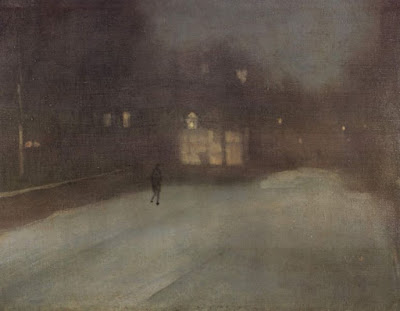Our sleep cycle was destroyed by gas lighting and factory night-shifts. How do we get it back?
 |
|
Arkwright’s Cotton Mills by Night, c. 1782, Joseph Wright of Derby, courtesy Wikiart.
|
As we close in on the winter solstice, dusk falls at a little after 3 PM here. My ancestors would have crawled into bed early and slept long. Instead, I click on the lights and continue to work or play with my phone until 10 PM.
Looking out my nephew’s bedroom window on Thanksgiving night, I noticed that it wasn’t truly dark. The sky was a lovely phthalo blue, with a band of light at the horizon. That was Washington, DC, 65 miles away.
Meanwhile, we suffer an international epidemic of insomnia. How did we get here, and how do we get back? According to the World Health Organization, two-thirds of adults in developed nations aren’t getting the recommended 8 hours of sleep a night. There has been a global rise in sleep disorders such as insomnia and sleep apnea. In Japan, the average time spent asleep is just 6 hours and 22 minutes. It isn’t much better here, where we average 6.8 hours of sleep a night—down significantly over the last century. Since sleep deprivation is linked to a host of diseases from cancer to obesity to heart attacks to cognitive difficulties, that’s a very bad trend.
Joseph Wright of Derby was a painter of the early Industrial Revolution. He loved nocturnes and dramatic candlelit scenes, and he’s been called “the first professional painter to express the spirit of the Industrial Revolution.” Wright also painted one of the first visual records of round-the-clock manufacturing with Arkwright’s Cotton Mills by Night, above. Sir Richard Arkwright, the owner, was Wright’s friend and patron.
 |
|
Arkwright’s Cotton Mills by Day, date unknown, Joseph Wright of Derby, courtesy Derby Museum and Art Gallery
|
Arkwright is credited with developing the modern factory system, combining a power source, machinery, semi-skilled labor and cotton fiber to create mass-produced yarn. He started life as the son of a tailor. Unable to go to school, Arkwright learned to read and write from a cousin. He was apprenticed and then set up shop as a barber and wigmaker in the early 1760s. There he invented a waterproof dye for the trendy periwigs of the time. The income from this would fund his industrial expansion.
Arkwright helped develop carding and spinning machinery (the next phase after the early spinning jenny), but it was his development of 24-hour factory mills that made him rich.
 |
|
Willersley Castle, date unknown, by Joseph Wright of Derby, courtesy Derby Museum and Art Gallery. This is the home that Sir William Arkwright built on his manufacturing success.
|
As his mills expanded, it became apparent that the local community couldn’t provide enough labor. Arkwright brought in workers and built them cottages and a public house. Work was organized in two 13-hour shifts per day. The factory gates closed precisely an hour after the first bell was rung. Latecomers were shut out and lost a day’s wages. Whole families were employed, including children as young as seven. Employees received a week’s vacation a year, provided that they didn’t leave town. Arkwright made a fortune and received a knighthood for developing this system, which, ironically, destroyed the same social fluidity that enabled him to escape poverty.
 |
|
The Bridge Nocturne aka Nocturne Queensboro Bridge, 1910, J. Alden Weir, courtesy Hirshhorn Museum and Sculpture Garden. It’s beautiful, but is it healthy?
|
The Industrial Revolution was the root of our modern insomnia, claims Jonathan Crary in 24/7: Late Capitalism and the Ends of Sleep. Before then, the midnight oil (literally) was an indulgence of the upper classes. Then came gaslight and Mr. Arkwright’s 24-hour mill, and out went regular sleep.
Like many American families, we’ve invited the 24-hour mill into our cottage. There is a bank of monitors in my husband’s office, because he’s a telecommuter. He’s often there at 10 PM finishing up work.
 |
|
Winter, Midnight, 1894, Childe Hassam, courtesy Columbus Museum of Art
|
It’s not just work that murders sleep. Netflix’ CEO Reed Hastings famously said that sleep is the company’s biggest competitor. “You know, think about it, when you watch a show from Netflix and you get addicted to it, you stay up late at night.
“We’re competing with sleep, on the margin. And so, it’s a very large pool of time.”





